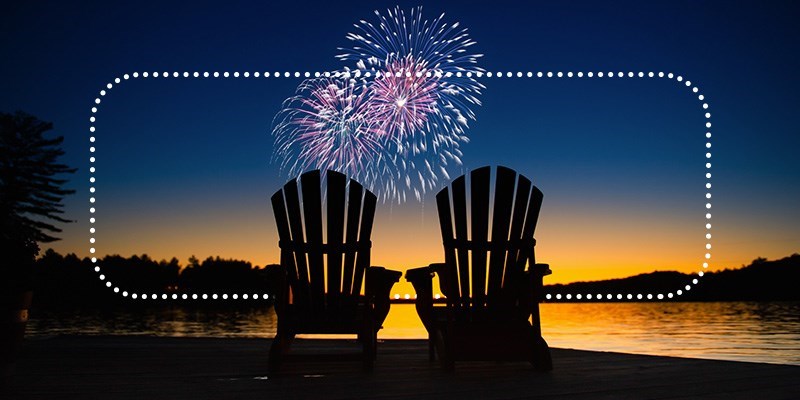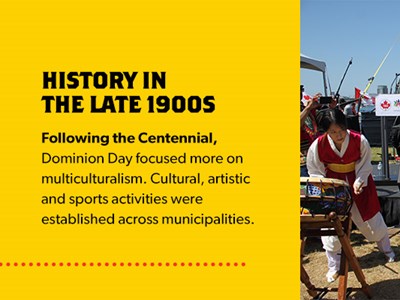Your cart is empty!
Make checkout easy by booking all your reservations at once. Add your sites from different campgrounds into your shopping cart* and then choose checkout.

On July 1st, Canadians around the world celebrate their country's history, culture and achievements. Canada's national holiday, Canada Day, has been a national celebration since 1868. The date champions the day Canada was recognized as an autonomous nation by Great Britain.
Since its conception, Canada Day has had a rich history. From earning its official status as a holiday to getting renamed, Canada Day history is full of interesting developments. Here is an overview of the history of the Canada Day celebration.
Canada Day officially started after the passage of the British North America Act of 1867. This document was ratified on July 1, 1867, and established the country of Canada as a federation. It included four initial provinces:
The act also provided provisions for other territories to join in the future. This act was later known as the Constitution Act and was viewed as the Constitution until Canada adopted its own Constitution in 1982.
The following year, the Canadian governor called for a celebration of the passage to be held on July 1st. Several bills were also proposed in the following years to make the day a public holiday in Canada, but none were passed successfully. People held small festivities in the years after.
However, Senator Robert Carrall successfully sponsored a bill through Parliament in 1879 that made July 1st a public holiday. Referred to as “Dominion Day,” the holiday would celebrate the anniversary of Canada's independence.
In the first years of Dominion Day, provinces organized local festivities. Canadians held bonfires, picnics, sporting events, parades and much more. Fireworks were staples of the events. Canadians showed pride in their country and spoke about their hopes for the future. Overall, Dominion Day was established as an important holiday for Canadians worldwide.
Canadians continued honoring Dominion Day in the early 1900s. July 1st, 1917, was the 50th anniversary of Dominion Day, and the federal government created significant plans for its festivities. However, the first World War disrupted these plans. Instead, Canadians held the Diamond Jubilee celebrations 10 years later in 1927, on the event's 60th anniversary.
The Diamond Jubilee was sponsored by the federal government and featured events like:
Viscount Willington, the Governor General at the time, also laid the cornerstone of the Confederation Building in Ottawa.
Following the Jubilee, the government planned Dominion Day festivities for each year afterward. They developed cherished traditions, like flag ceremonies on Parliament Hill and concerts with military music and fireworks.
With each year, Canadians cemented Dominion Day as a cherished national holiday. Canadians around the globe also celebrated their heritage, no matter how far they were from their country.
Canada Day's development furthered in the late 1900s. In the late 1950s, Prime Minister John Diefenbaker urged even larger celebrations of Dominion Day. He hoped to revitalize cultural pride in Canada and encouraged discussion of the country's previous British heritage.
Throughout the 1960s, officials focused on performances for Dominion Day. Performers traveled across the country for the yearly festivities on Parliament Hill. Officials began televising performances for the entire country. The broadcasts allowed more people to learn about Canada Day and its importance to the country's culture. As more people were exposed to the holiday, the more it grew in popularity. Festivities grew in size across the country.
On July 1st, 1967, Canada held its 100th anniversary of the Confederation. Celebrations for Canada's 100th anniversary were held throughout the year and culminated on July 1st. The Centennial was a massive event, including a visit from Queen Elizabeth II. Officials also made commemorative coins and other items celebrating the year.

Following the Centennial, Dominion Day focused more on multiculturalism. Cultural, artistic and sports activities were established across municipalities. People started centering celebrations locally in their provinces. The government provided extra start-up funding for local towns to hold their festivities.
The 1980s also featured significant developments in the holiday's culture. The traditional tune, “O Canada” became the Canadian national anthem on Dominion Day in 1980. In 1981, officials started setting off fireworks in 15 Canadian cities for Dominion Day. This tradition continues today.
The name “Dominion Day” was officially changed to “Canada Day” in 1982. From that point on, Canada's commemorative celebration was known as Canada Day.
Now officially referred to as Canada Day, the festivities are still integral across the country. The annual events still feature staple traditions like:
These events are still centered on Parliament Hill in Ottawa, but all provinces hold local celebrations, too.
The 2010s had two significant visits:
As the 2010s progressed, Canada Day reached its 150th birthday. For the first time, the Prince of Wales and Duchess of Cornwall visited Parliament Hill for the milestone event.
Canada Day will undoubtedly continue to be a celebrated tradition for Canadians for many years to come.
Canadians celebrate Canada Day in many ways. From visiting family to hosting parades, you are sure to find an exciting way to honor your country's pride. Many Canadians spend the holiday outdoors, enjoying their beautiful country's natural landscapes — and a great way to get outdoors is by camping.
Sault Ste. Marie KOA Holiday offers stunning camping accommodations for Canadians. Our beautiful Ontario campground is perfect for a Canada Day celebration with your whole family. Whether you want to bring your RV, set up a tent or relax in one of our gorgeous cabins, we have an opportunity for you. With local events like farmer's markets, local shops and concert series, you will find fun at every turn.
Our Ontario campground features:
Start planning your Canada Day getaway with Sault Ste. Marie KOA Holiday. Find the perfect campsite for you and your family today.
That doesn't mean this area has to always be empty. When you start reviewing camping options, your history will display here to help compare sites and find the best stay. You will be able to share your stay information with friends or family and save it for a later time if you have a KOA Account.
Make checkout easy by booking all your reservations at once. Add your sites from different campgrounds into your shopping cart* and then choose checkout.